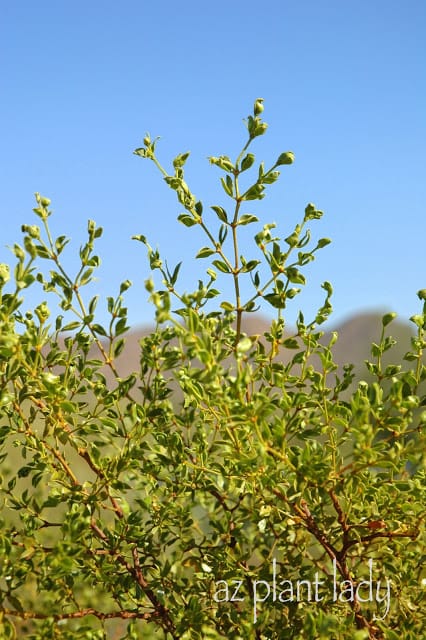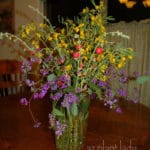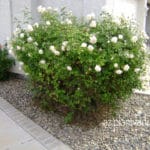A Desert Shrub That Smells Like Rain?
A Desert Shrub that Smells Like Rain
Someone once commented about how much they loved the wonderful smell of rain in the desert. This person had moved away and they missed the characteristic fragrance that permeates the desert air when the rains came. People who have not visited the southwestern parts of the US may wonder what on earth she was talking about.
The Aromatic Wonder: Creosote (Larrea tridentata)
Well, there is a shrub that can be seen growing predominately throughout the desert southwest. It releases a wonderful fragrance whenever it rains. This shrub is known as creosote (Larrea tridentata).

This characteristic desert shrub can be found growing in the California desert. It also grows in the southern third of Arizona, New Mexico and the western half of Texas otherwise known as the Mojave, Sonoran, and Chihuahuan deserts.
Genetic Mysteries of Creosote Shrubs
I am a bit of a science geek. What I find fascinating is that creosote shrubs are classified as a single species. But depending on what desert they are growing in, have different chromosome numbers. Those found in Texas have 26 pairs. While in Arizona they have 52 pairs and in California they have 78 pairs. Some scientists theorize that the creosote found in California evolved from those in the Arizona desert. The higher chromosome count somehow enabled them to survive the drier conditions of the Mojave Desert.
Believe it or not, some colonies in the Mojave desert are absolutely ancient — over 11,500 years old.

The Resinous Defenders: Adaptations of Creosote
Their small leaves are covered with resin to protect against water loss and from being eaten. It is widely thought that creosote produces a toxin or uses up all available water to keep other plants from growing close by therefore keeping competition for limited resources to a minimum.
Creosote’s Influence on the Landscape
I had a client who had a large beautiful creosote growing in their garden. She also had a boxwood hedge that was thriving, except for one area where a few boxwood shrubs were yellow and sickly. They had been that way for years. Coincidentally those sickly shrubs were a few feet away from the creosote.

Growing Creosote in Your Desert Landscape
Creosote can be grown in the desert landscape under 5,000 ft. They do best with limited water and grow slowly. In their native habitat, they typically grow to 4 feet in height. But in a landscape setting, they can reach heights of up to 12 feet.
Propagating Creosote: Tips and Tricks
To start from seed, pour boiling water over the seeds and let sit overnight. Then plant in soil and water. As the plant grows, slowly taper off the water. I recommend only watering a mature creosote, to a depth of 2 feet, 2 to 3 times in the summer. They can survive without any supplemental water.
Enjoying the Fragrance: A Desert Delight
Another interesting fact – did you know that you don’t have to wait for it to rain to enjoy the fragrance of this shrub? All you need to do is take a few leaves from the creosote and rub them between your fingers and you’ll be able to smell the refreshing scent of rain that is so characteristic of the Southwest.

 Noelle Johnson, aka, 'AZ Plant Lady' is a author, horticulturist, and landscape consultant who helps people learn how to create, grow, and maintain beautiful desert gardens that thrive in a hot, dry climate. She does this through her consulting services, her online class Desert Gardening 101, and her monthly membership club, Through the Garden Gate. As she likes to tell desert-dwellers, "Gardening in the desert isn't hard, but it is different."
Noelle Johnson, aka, 'AZ Plant Lady' is a author, horticulturist, and landscape consultant who helps people learn how to create, grow, and maintain beautiful desert gardens that thrive in a hot, dry climate. She does this through her consulting services, her online class Desert Gardening 101, and her monthly membership club, Through the Garden Gate. As she likes to tell desert-dwellers, "Gardening in the desert isn't hard, but it is different."









Hi Noelle~~ When you wrote "a shrub that smells like rain" I immediately thought of my Lonicera tatarica 'Arnold Red' blooming now. I swear the blossoms smell like the freshness of rain.
Creosote looks like a very adaptable and lovely shrub.
I love the way things smell after it rains….I bet I would love this shrub…nice information here.
That is a very interesting shrub! Pretty as well. Thanks for sharing it with us!
What a beautiful post, Noelle. It felt almost poetic somehow, a shrub descended from thousands of years of lovely, if poisonous, survivors, that smells like rain in the desert.
When we were in the desert on our vacation, it rained one day — for about 10 minutes (nothing to those of us from the muggy Southeast), and then we saw the most fabulous double rainbows stretched from horizon to horizon. The very air itself seemed to recognize how precious the rains there are, no matter how brief.
I love Florida more than anything, but I really miss that smell from when I lived in barstow. A great and informative post!
I love the photo of this tree…it looks like I want to paint it, or draw it with a meandering pencil tip. Interesting info on it, too. Old, sticky and fragrant! 🙂 Great post!
Noelle: This is very interesting fact about this beautiful shrub! I am imagining that smell in my mind when reading it!
BTW, thanks for leaving the comment on my new garden corner and the agaves I planted. I wanted you know that actually I did read one of your older posts about the agaves in your garden. Yours look awesome with gravel mulch and big space in between. Too bad that I don't have much garden space to spread them out.
They are amazing plants. There's a photo of the 11,000 year old creosote ring taken by a photographer who is photographing the oldest plants in the world:
http://www.rachelsussman.com/portfolios/OLTW/creosote_3.html
Last summer I was camping in a field of artemisia tridentata on the east side of the Sierras for a month. Smelled great after an afternoon rain.
Never thought there is something like the smell of a rain. It rains almost everyday here now and I doubt I smell anything.
pouring boiling water over the seed – that is surely interesting. I guess this plant thrives after a forest fire?
Very interesting and fascinating post Noelle! Amazing to read the age of some. I love the blooms and fruit as well as the contrast of leaf and bark. Beautiful!
I had no idea that the creosote shrub has such a wonderful fragrance.
Does this tree have any relationship to the chemical creosote that is used to preserve wood? Just wondering, since this tree lives so long. Of course, that stuff doesn't smell like rain at all!
Another new and interesting plant you've introduced me to! I was thinking the same thing that debsgarden asked.
I love this plant, and our deserts would be so bare without it. A couple weeks ago they were blooming like crazy–a terrific sight. I didn't know the detail about the chromosome numbers but you can see how they're multiples of the Texas form. With different numbers like that I wonder if that would render hybrids between the forms sterile, keeping the separate forms distinct…
I do miss the smell of a desert rain. The rain in the desert is always something awe-inspiring. I knew some of you interesting facts about the creosote (like the toxin to keep away pesky resource hogging neighbors), but others were definitely new. The chromosome count is fascinating. That's a very different count depending on the range. Thanks for the info.
Love your post. We were in the desert a few weeks ago and I saw these creosite bushes. I absolutely love learning about the flora in the desert and I wasn't familiar with this one. We usually visit the desert near Moab, UT and I don't think I've seen this one growing there. So I looked it up, but didn't get the wealth of info you just posted. We are headed back to the desert in about a week, can't wait to try smelling the leaves.
Rthoseweeds
I have never heard of a plant that smells like rain. What a wonderful scent! Great post and informative.
I saw several of these creosotes this past week, Noelle, but I didn't realize they smelled like rain. Now I wish I had rubbed their leaves to smell them! I also didn't know they put out such pretty blooms.
I had a wonderful week enjoying the beautiful sights of Phoenix, including a long visit at the DBG. There's always something new to see there. Perhaps on my next trip out we can meet up. Looks like you had a busy but enjoyable spring break!
I don't know the creosote plant. I too wondered about the relationship to chemical creosote, which has a strong odor of phenol (PCP).
The only bouquet I've had lately was Erlicheer daffodils that flopped from the rain and the exuberance of the dog.
Erlicheer in They Call It Spring
They were too fragrant to bring into the house.
Me too. I grew up in Fort Irwin and now live in Jacksonville Florida. I miss the smell soooo much. I am trying to figure out what the smell was so that I can find an oil to put into my essential oil diffuser.
Hi! I absolutely love this smell. Does it occur only when I rains? Or on its own??
Hi Kristina,
It does smell when it rains. But, you can also capture the same smell if you crush a few leaves between your fingers 🙂
Noelle
Thank you for the quick reply!!
My friend from Arizona had some dried creosote. She kept it in a box and it still had the strong smell. Is this something that's hard to do? I looked online for some information or some to purchase but no information was available other than medicinal purposes. I simply want it for the beautiful aroma. Do you know anything about this?
I thought about growing the plant myself as I have the climate for it, but I'm not sure if I would get the results I'm after for my project.
Hi Kristina,
Here, you can buy creosote and grow it, but it grows very slowly and can be hard to establish because it is easy to over water it.
Some people who have homes with native desert areas, do have access to creosote. I don't have any in my garden 🙁
Noelle
Thank you for this informative article. I drive a semi truck out in these areas often and have wondered what the smell was.